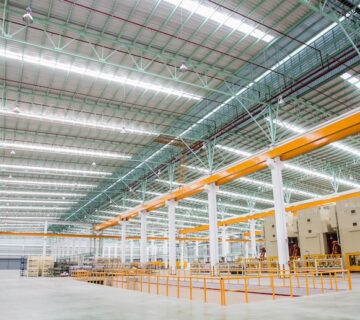Painting a warehouse involves more than just adding paint; it’s a strategic process that plays with color and sheen to enhance the perception of space and light. By carefully considering the warehouse’s architecture and lighting, a well-executed paint job can completely change the space, making it seem larger and brighter. This transformation doesn’t just improve aesthetics; it can also boost workflow efficiency and lift employee morale. Ultimately, it may even contribute to the psychological well-being of the workers.
Understanding Color Dynamics
The choice of color in a warehouse significantly impacts the perception of space. Lighter colors, like whites and pastels, reflect more light, effectively making a space feel larger and more open, an advantage in expansive warehouse environments. Conversely, darker colors can make a large warehouse feel more compact and less overwhelming, potentially useful in areas designated for storage or focused work. The strategic application of color can also delineate different areas, aiding in organization and spatial awareness.
Utilizing Reflective Paints
Reflective paints have a profound impact on warehouses, particularly where lighting efficiency is crucial. By bouncing light, these paints diminish the necessity for extra light fixtures, resulting in notable energy conservation and fostering a more luminous workspace. When applied to ceilings and tall walls, reflective paints mitigate glare, enhancing visibility and alleviating eye strain among employees. This aspect is pivotal for maintaining focus on safety and productivity.
The Role of Sheen
The sheen of the paint plays a critical role in both aesthetics and functionality. High-gloss finishes are highly reflective and can help to maximize light dispersion throughout the warehouse, contributing to the illusion of a more expansive interior. However, they can also highlight imperfections on the surfaces. Semi-gloss or satin finishes offer a compromise, providing a level of reflectivity that enhances light without overly emphasizing surface flaws. These sheens can be particularly effective in high-traffic areas, where they can endure repeated cleaning without losing their luster.
Color Zoning for Organization
Employing varied colors to delineate distinct areas or zones within a warehouse can significantly enhance organization and streamline workflow. This practice, known as color zoning, simplifies navigation and identification within large and intricate warehouse layouts. By implementing color-coded pathways leading to various sections, workers and visitors can navigate with greater ease, minimizing errors and accidents.
Enhancing Safety with Color
In a warehouse environment, safety is of paramount concern. Bright, contrasting colors for safety markings, walkways, and hazardous areas not only enhance the functionality of the space but also significantly contribute to safety. They ensure that safety features are highly visible and clearly communicate warnings and information. For example, vibrant yellows or reds can signal caution, while stripes or patterns can denote pathways or boundaries.
Balancing Aesthetics and Functionality
Though warehouses are primarily functional spaces, neglecting aesthetics would be shortsighted. A tastefully painted, well-lit, and orderly warehouse can significantly boost employee morale and foster a more enjoyable work atmosphere. Balancing aesthetics with practicality not only enhances workplace culture but also strengthens a company’s brand identity.
Final Thoughts
Strategically using color and sheen in warehouse painting isn’t just about aesthetics; it’s crucial for optimizing space and light functionality. A well-considered approach can turn a warehouse into a safer, more efficient, and pleasant workspace, benefiting everyone involved. Whether the aim is safety enhancement, efficiency boost, or fostering a better work environment, careful attention to painting can greatly impact a warehouse’s success. For more tips on commercial painting and maximizing your warehouse space, visit our website at sisupainting.com and our blog at sisupainting.com/blog.





No comment